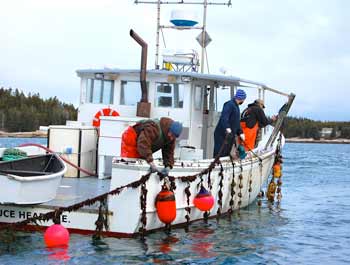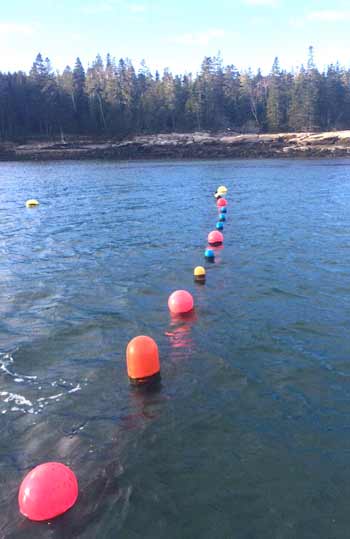Maine Scallop Aquaculture Coop Works Toward Fishery Diversification
by Sarah Craighead Dedmon

“We’ve all been involved in a whole bunch of different fisheries. For all of us, it seemed right to see if we can develop something that’s sustainable in Maine.” – Marsden Brewer, lobsterman, Stonington, Maine Maine Aquaculture Coop photo
A group of nine midcoast fishermen and aquaculturists have joined together to form Maine’s first scallop farming cooperative. The Maine Aquaculture Co-op is starting small, setting up scallop farms on three aquaculture lease sites, with applications in place for a fourth.
“We’d like to build a year-round opportunity for commercial fishermen,” said Luke Holden, founder of Luke’s Lobsters and co-op member-at-large, “At the end of the day, you’re paying insurance and your mortgage on your boat for 12 months a year, we want to help fishermen reach closer to 100% utilization.”
Merritt Carey, who helped found the co-op, says that the co-op business model was an easy choice for scallop farming, “Cooperatives are a really natural way to do this type of work, especially in an industry that’s in its infancy,” said Carey, ”Fishermen get the co-op idea. It’s a way to bring people together and leverage physical and intellectual assets in order to move something forward.”
In the co-op model, participants procure their own aquaculture leases from the Maine Department of Marine Resources, but share expenses for things like processing equipment and marketing. They sell their product collectively, with some money from each sale set aside to cover the co-op’s operating expenses. If all goes well and the co-op is able to operate efficiently, each participant receives a dividend check at the end of the year.
According to Maine Sea Grant’s Dana Morse, scallop farming is a relative newcomer to Maine’s fisheries. “We’re still at a pretty early phase in the development of scallop farming, particularly in the ear-hanging process,” said Morse, who wrote extensively on the technique in the March 2017 edition of this paper.
Ear-hanging is a scallop farming method practiced in Japan since the 1950s in which small holes are drilled through the back hinge of the juvenile scallop shell. The scallops are pinned in pairs to vertical ropes hung from underwater lines, and the farm is suspended below the surface using a combination of anchors and buoys. “The early research that we’ve done with this method of growing scallops leaves everybody cautiously optimistic,” said Morse, “Farming is farming, not to paint too rosy a picture. But the early results have been good.”
Morse says that he enjoys working with the Maine Aquaculture Co-op because so many members are commercial fishermen, “So, they’re in a good position to identify good sites, where there’s really minimal conflict with other fisheries, such as lobster.”
Marsden Brewer is a lobster fisherman from Stonington who serves as the co-op’s president. “I’ve been involved with scallops for quite a while, started collecting spat back in 1998,” said Brewer. Spat are baby scallops. Last fall, Brewer traveled to Japan with fellow fishermen and co-op members, Peter Miller and Skip Gordon to study the Japanese scallop fishery. “We’ve all been involved in a whole bunch of different fisheries,” said Brewer. “For all of us, it seemed right to see if we can develop something that’s sustainable in Maine.”
Brewer was impressed by a unique scallop product he found in Japan, “One of the products is a ‘half-mature product,’” said Brewer. In the ear-hanging method, juvenile scallops are raised in a series of spat bags until they are large enough to be pinned to ropes in the farm. There are always more scallops than rope, leaving an excess of small, 2-inch scallops. “So the Japanese solved the problem by selling the scallops off when it gets to that stage,” said Brewer, “It makes for a bite-sized little morsel. They use them in everything.”

Buoys mark submerged rope from which lines with scallops attached are suspended. “Fishermen are in a good position to identify good sites, where there’s really minimal conflict with other fisheries, such as lobster.” – Dana Morse.
Wild Maine scallops are harvested when the shell is 4 inches or greater, so the Maine market has never encountered scallops of this size.
Brewer said he sees potential for developing a new market for this smaller product, as well as other products such as “roe-on” scallops, scallops served whole with the scallop eggs and other organs in place. Current Maine regulations prohibit the sale of anything but the scallop adductor muscle, because other parts of the animal can harbor toxins such as red tide.
However, Morse says it may eventually be possible to evaluate the safety of selling the whole scallop, “We are about to expand our testing for scallops so that we can better understand how the toxins specifically, within the roe, sort of wax and wane over time, “ said Morse, “We’re trying to do the science to make sure that testing can happen affordably for a producer, in a way that ensures a safe product is on the market.”
“There’s an increasing demand for more diversified offerings when it comes to seafood,” said Carey, ”If you can produce these offerings locally and sustainably, well, that’s a great product with a great story.”
Togue Brawn, owner of Downeast Dayboats, said scallop farming is a uniquely sustainable fishery. “I think farmed scallops are this rare situation where the cultured scallops actually help the wild industry,” said Brawn, who ships Maine scallops nationwide from her company’s headquarters in Cape Elizabeth. Brawn said that when mature scallops are hanging in the farms, they release larvae that help replenish wild scallop populations. “One of the things we fight against in terms of differentiating our Maine brand is that we have a short season. One option is frozen scallops, and another is farmed scallops,” said Brawn, “I would love to help promote farmed scallops.”
Miller, who has worked as a commercial fisherman for over 40 years, said that eventually, a fisherman could use a scallop farm to bring in an extra $20,000 to $40,000 per year, even with a small aquaculture lease. “We’re interested in involving small aquaculturists and lobstermen who don’t have any diversification options to say, ‘This is something you can do. You can supplement your lobstering income,’” said Miller, “The next generation that can’t get a scallop license, if the lobstering goes down, where are they going to be?”
“There are three members, myself, Skip and Marsden,” said Miller, “Realistically we’re all too old to get much out of this. I’m going to claim that we’re all wearing a white hat and we’re doing it for the good of the coast of Maine.”
